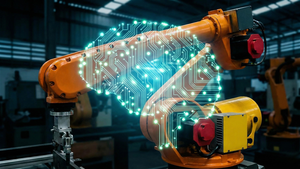
A century ago, the seeds of a technological revolution were sown with the theoretical conception of the field-effect transistor (FET). From humble beginnings as an unrealized patent, the FET has evolved into the indispensable bedrock of modern electronics, quietly enabling everything from the smartphone in your pocket to the supercomputers driving today's artificial intelligence breakthroughs. As we mark a century of this transformative invention, the focus is not just on its remarkable past, but on a future poised to transcend the very silicon that defined its dominance, propelling AI into an era of unprecedented capability and ethical complexity.
The immediate significance of the field-effect transistor, particularly the Metal-Oxide-Semiconductor Field-Effect Transistor (MOSFET), lies in its unparalleled ability to miniaturize, amplify, and switch electronic signals with high efficiency. It replaced the bulky, fragile, and power-hungry vacuum tubes, paving the way for the integrated circuit and the entire digital age. Without the FET's continuous evolution, the complex algorithms and massive datasets that define modern AI would remain purely theoretical constructs, confined to a realm beyond practical computation.
From Theoretical Dreams to Silicon Dominance: The FET's Technical Evolution
The journey of the field-effect transistor began in 1925, when Austro-Hungarian physicist Julius Edgar Lilienfeld filed a patent describing a solid-state device capable of controlling electrical current through an electric field. He followed with identical U.S. patents in 1926 and 1928, outlining what we now recognize as an insulated-gate field-effect transistor (IGFET). German electrical engineer Oskar Heil independently patented a similar concept in 1934. However, the technology to produce sufficiently pure semiconductor materials and the fabrication techniques required to build these devices simply did not exist at the time, leaving Lilienfeld's groundbreaking ideas dormant for decades.
It was not until 1959, at Bell Labs, that Mohamed Atalla and Dawon Kahng successfully demonstrated the first working MOSFET. This breakthrough built upon earlier work, including the accidental discovery by Carl Frosch and Lincoln Derick in 1955 of surface passivation effects when growing silicon dioxide over silicon wafers, which was crucial for the MOSFET's insulated gate. The MOSFET’s design, where an insulating layer (typically silicon dioxide) separates the gate from the semiconductor channel, was revolutionary. Unlike the current-controlled bipolar junction transistors (BJTs) invented by William Shockley, John Bardeen, and Walter Houser Brattain in the late 1940s, the MOSFET is a voltage-controlled device with extremely high input impedance, consuming virtually no power when idle. This made it inherently more scalable, power-efficient, and suitable for high-density integration. The use of silicon as the semiconductor material was pivotal, owing to its ability to form a stable, high-quality insulating oxide layer.
The MOSFET's dominance was further cemented by the development of Complementary Metal-Oxide-Semiconductor (CMOS) technology by Chih-Tang Sah and Frank Wanlass in 1963, which combined n-type and p-type MOSFETs to create logic gates with extremely low static power consumption. For decades, the industry followed Moore's Law, an observation that the number of transistors on an integrated circuit doubles approximately every two years. This led to a relentless miniaturization and performance increase. However, as transistors shrunk to nanometer scales, traditional planar FETs faced challenges like short-channel effects and increased leakage currents. This spurred innovation in transistor architecture, leading to the Fin Field-Effect Transistor (FinFET) in the early 2000s, which uses a 3D fin-like structure for the channel, offering better electrostatic control. Today, as chips push towards 3nm and beyond, Gate-All-Around (GAA) FETs are emerging as the next evolution, with the gate completely surrounding the channel for even superior control and reduced leakage, paving the way for continued scaling. The initial reaction to the MOSFET, while not immediately recognized as superior to faster bipolar transistors, soon shifted as its scalability and power efficiency became undeniable, laying the foundation for the integrated circuit revolution.
AI's Engine: Transistors Fueling Tech Giants and Startups
The relentless march of field-effect transistor advancements, particularly in miniaturization and performance, has been the single most critical enabler for the explosive growth of artificial intelligence. Complex AI models, especially the large language models (LLMs) and generative AI systems prevalent today, demand colossal computational power for training and inference. The ability to pack billions of transistors onto a single chip, combined with architectural innovations like FinFETs and GAAFETs, directly translates into the processing capability required to execute billions of operations per second, which is fundamental to deep learning and neural networks.
This demand has spurred the rise of specialized AI hardware. Graphics Processing Units (GPUs), pioneered by NVIDIA (NASDAQ: NVDA), originally designed for rendering complex graphics, proved exceptionally adept at the parallel processing tasks central to neural network training. NVIDIA's GPUs, with their massive core counts and continuous architectural innovations (like Hopper and Blackwell), have become the gold standard, driving the current generative AI boom. Tech giants have also invested heavily in custom Application-Specific Integrated Circuits (ASICs). Google (NASDAQ: GOOGL) developed its Tensor Processing Units (TPUs) specifically optimized for its TensorFlow framework, offering high-performance, cost-effective AI acceleration in the cloud. Similarly, Amazon (NASDAQ: AMZN) offers custom Inferentia and Trainium chips for its AWS cloud services, and Microsoft (NASDAQ: MSFT) is developing its Azure Maia 100 AI accelerators. For AI at the "edge"—on devices like smartphones and laptops—Neural Processing Units (NPUs) have emerged, with companies like Qualcomm (NASDAQ: QCOM) leading the way in integrating these low-power accelerators for on-device AI tasks. Apple (NASDAQ: AAPL) exemplifies heterogeneous integration with its M-series chips, combining CPU, GPU, and neural engines on a single SoC for optimized AI performance.
The beneficiaries of these semiconductor advancements are concentrated but diverse. TSMC, the world's leading pure-play foundry, holds an estimated 90-92% market share in advanced AI chip manufacturing, making it indispensable to virtually every major AI company. Its continuous innovation in process nodes (e.g., 3nm, 2nm GAA) and advanced packaging (CoWoS) is critical. Chip designers like NVIDIA (NASDAQ: NVDA), Intel (NASDAQ: INTC), and AMD (NASDAQ: AMD) are at the forefront of AI hardware innovation. Beyond these giants, specialized AI chip startups like Cerebras and Graphcore are pushing the boundaries with novel architectures. The competitive implications are immense: a global race for semiconductor dominance, with governments investing billions (e.g., U.S. CHIPS Act) to secure supply chains. The rapid pace of hardware innovation also means accelerated obsolescence, demanding continuous investment. Furthermore, AI itself is increasingly being used to design and optimize chips, creating a virtuous feedback loop where better AI creates better chips, which in turn enables even more powerful AI.
The Digital Tapestry: Wider Significance and Societal Impact
The field-effect transistor's century-long evolution has not merely been a technical achievement; it has been the loom upon which the entire digital tapestry of modern society has been woven. By enabling miniaturization, power efficiency, and reliability far beyond vacuum tubes, FETs sparked the digital revolution. They are the invisible engines powering every computer, smartphone, smart appliance, and internet server, fundamentally reshaping how we communicate, work, learn, and live. This has led to unprecedented global connectivity, democratized access to information, and fueled economic growth across countless industries.
In the broader AI landscape, FET advancements are not just a component; they are the very foundation. The ability to execute billions of operations per second on ever-smaller, more energy-efficient chips is what makes deep learning possible. This technological bedrock supports the current trends in large language models, computer vision, and autonomous systems. It enables the transition from cloud-centric AI to "edge AI," where powerful AI processing occurs directly on devices, offering real-time responses and enhanced privacy for applications like autonomous vehicles, personalized health monitoring, and smart homes.
However, this immense power comes with significant concerns. While individual transistors become more efficient, the sheer scale of modern AI models and the data centers required to train them lead to rapidly escalating energy consumption. Some forecasts suggest AI data centers could consume a significant portion of national power grids in the coming years if efficiency gains don't keep pace. This raises critical environmental questions. Furthermore, the powerful AI systems enabled by advanced transistors bring complex ethical implications, including algorithmic bias, privacy concerns, potential job displacement, and the responsible governance of increasingly autonomous and intelligent systems. The ability to deploy AI at scale, across critical infrastructure and decision-making processes, necessitates careful consideration of its societal impact.
Comparing the FET's impact to previous technological milestones, its influence is arguably more pervasive than the printing press or the steam engine. While those inventions transformed specific aspects of society, the transistor provided the universal building block for information processing, enabling a complete digitization of information and communication. It allowed for the integrated circuit, which then fueled Moore's Law—a period of exponential growth in computing power unprecedented in human history. This continuous, compounding advancement has made the transistor the "nervous system of modern civilization," driving a societal transformation that is still unfolding.
Beyond Silicon: The Horizon of Transistor Innovation
As traditional silicon-based transistors approach fundamental physical limits—where quantum effects like electron tunneling become problematic below 10 nanometers—the future of transistor technology lies in a diverse array of novel materials and revolutionary architectures. Experts predict that "materials science is the new Moore's Law," meaning breakthroughs will increasingly be driven by innovations beyond mere lithographic scaling.
In the near term (1-5 years), we can expect continued adoption of Gate-All-Around (GAA) FETs from leading foundries like Samsung and TSMC, with Intel also making significant strides. These structures offer superior electrostatic control and reduced leakage, crucial for next-generation AI processors. Simultaneously, Wide Bandgap (WBG) semiconductors like silicon carbide (SiC) and gallium nitride (GaN) will see broader deployment in high-power and high-frequency applications, particularly in electric vehicles (EVs) for more efficient power modules and in 5G/6G communication infrastructure. There's also growing excitement around Carbon Nanotube Transistors (CNTs), which promise significantly smaller sizes, higher frequencies (potentially exceeding 1 THz), and lower energy consumption. Recent advancements in manufacturing CNTs using existing silicon equipment suggest their commercial viability is closer than ever.
Looking further out (beyond 5-10 years), the landscape becomes even more exotic. Two-Dimensional (2D) materials like graphene and molybdenum disulfide (MoS₂) are promising candidates for ultrathin, high-performance transistors, enabling atomic-thin channels and monolithic 3D integration to overcome silicon's limitations. Spintronics, which exploits the electron's spin in addition to its charge, holds the potential for non-volatile logic and memory with dramatically reduced power dissipation and ultra-fast operation. Neuromorphic computing, inspired by the human brain, is a major long-term goal, with researchers already demonstrating single, standard silicon transistors capable of mimicking both neuron and synapse functions, potentially leading to vastly more energy-efficient AI hardware. Quantum computing, while a distinct paradigm, will also benefit from advancements in materials and fabrication techniques. These innovations will enable a new generation of high-performance computing, ultra-fast communications for 6G, more efficient electric vehicles, and highly advanced sensing capabilities, fundamentally redefining the capabilities of AI and digital technology.
However, significant challenges remain. Scaling new materials to wafer-level production with uniform quality, integrating them with existing silicon infrastructure, and managing the skyrocketing costs of advanced manufacturing are formidable hurdles. The industry also faces a critical shortage of skilled talent in materials science and device physics.
A Century of Control, A Future Unwritten
The 100-year history of the field-effect transistor is a narrative of relentless human ingenuity. From Julius Edgar Lilienfeld’s theoretical patents in the 1920s to the billions of transistors powering today's AI, this fundamental invention has consistently pushed the boundaries of what is computationally possible. Its journey from an unrealized dream to the cornerstone of the digital revolution, and now the engine of the AI era, underscores its unparalleled significance in computing history.
For AI, the FET's evolution is not merely supportive; it is generative. The ability to pack ever more powerful and efficient processing units onto a chip has directly enabled the complex algorithms and massive datasets that define modern AI. As we stand at the precipice of a post-silicon era, the long-term impact of these continuing advancements is poised to be even more profound. We are moving towards an age where computing is not just faster and smaller, but fundamentally more intelligent and integrated into every aspect of our lives, from personalized healthcare to autonomous systems and beyond.
In the coming weeks and months, watch for key announcements regarding the widespread adoption of Gate-All-Around (GAA) transistors by major foundries and chipmakers, as these will be critical for the next wave of AI processors. Keep an eye on breakthroughs in alternative materials like carbon nanotubes and 2D materials, particularly concerning their integration into advanced 3D integrated circuits. Significant progress in neuromorphic computing, especially in transistors mimicking biological neural networks, could signal a paradigm shift in AI hardware efficiency. The continuous stream of news from NVIDIA (NASDAQ: NVDA), Intel (NASDAQ: INTC), AMD (NASDAQ: AMD), Google (NASDAQ: GOOGL), and other tech giants on their AI-specific chip roadmaps will provide crucial insights into the future direction of AI compute. The century of control ushered in by the FET is far from over; it is merely entering its most transformative chapter yet.
This content is intended for informational purposes only and represents analysis of current AI developments.
TokenRing AI delivers enterprise-grade solutions for multi-agent AI workflow orchestration, AI-powered development tools, and seamless remote collaboration platforms.
For more information, visit https://www.tokenring.ai/.








